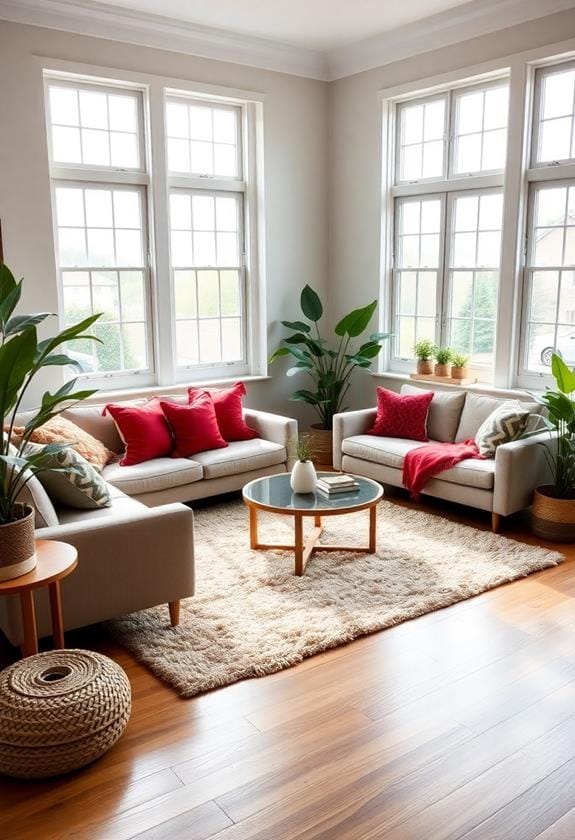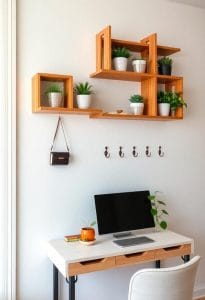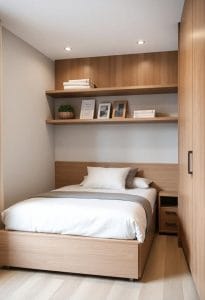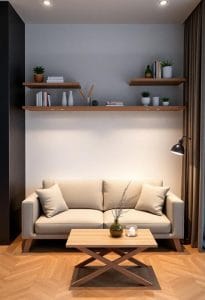Optimizing a small living room requires smart design choices that maximize space and style. Start by making the most of vertical space with tall shelving and wall-mounted TVs to keep the floor clear. Choose furniture that's multi-functional, like sofa beds and storage ottomans, to enhance utility without clutter. Embrace minimalism by focusing on essential items and adopting a light color palette to create an airy feel. Define zones within your room using rugs and strategic furniture placement. Use mirrors to reflect light and create the illusion of more space. As you refine your layout, new transformations await.
Key Points
- Maximize vertical space with tall shelving units and wall-mounted cabinets to increase storage without occupying floor space.
- Choose multi-functional furniture like sofa beds and coffee tables with hidden storage to enhance utility and reduce clutter.
- Embrace minimalism by focusing on essential items and maintaining a neutral color palette for an open and inviting atmosphere.
- Define zones using furniture arrangement and small rugs to delineate spaces for different activities within the room.
- Use compact furniture with slender legs and glass tops to create an illusion of openness and adaptability in layout.
Maximize Vertical Space
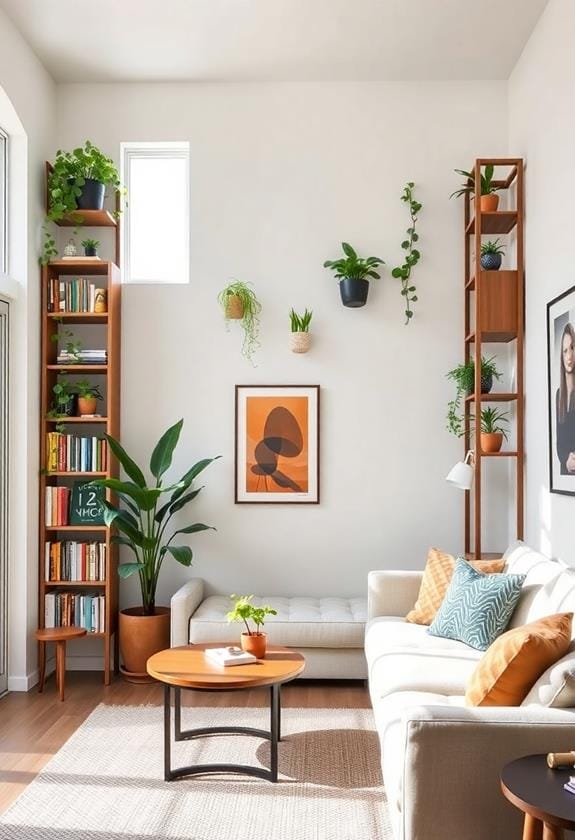
When it comes to maximizing vertical space in a small living room, think of your walls as untapped potential. By creatively utilizing these surfaces, you can free up valuable floor space and create a more open environment. Start by installing tall shelving units that draw the eye upward, making the room feel more expansive. These shelves can hold books, decorative items, or even storage baskets, keeping clutter at bay. For those interested in innovative solutions, consider exploring vertical storage ideas to maximize efficiency in tight spaces. Don't shy away from using the full height of your walls, as it helps make the most of every inch available.
Consider adding floating shelves or wall-mounted cabinets for a sleek, modern look without sacrificing functionality. They're perfect for displaying art, family photos, or a small indoor plant collection. A vertical gallery wall can also add personality and style without consuming floor space. If you have a television, try wall-mounting it to keep surfaces clear, giving a cleaner, more organized appearance.
Choose Multi-Functional Furniture
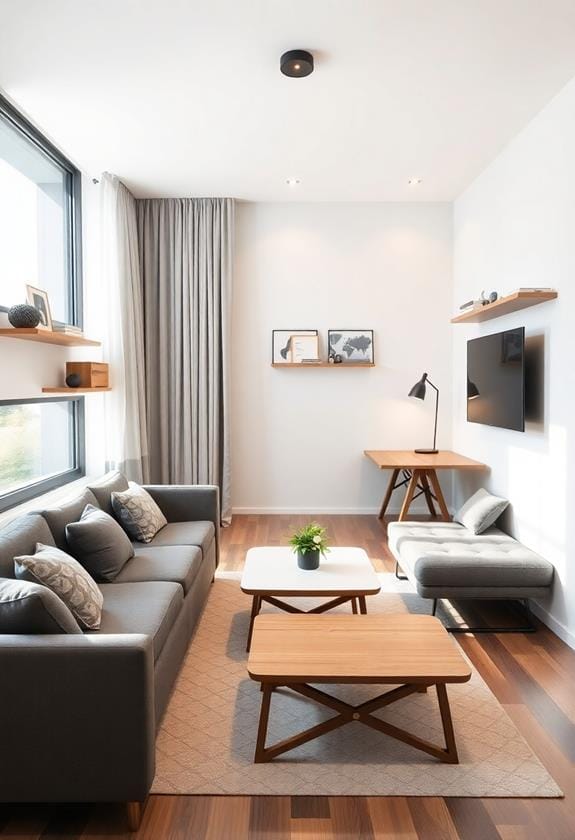
Although small living rooms can pose a challenge, choosing multi-functional furniture can greatly enhance their usability. By selecting pieces that serve more than one purpose, you can maximize every inch of your space, making it both practical and stylish. Consider investing in a sofa bed, which provides a comfortable seating area by day and transforms into a cozy bed by night, perfect for accommodating overnight guests without sacrificing space.
Opt for coffee tables with hidden storage compartments, allowing you to keep the area tidy by stashing away magazines, remote controls, or other small items. An ottoman or a bench with built-in storage can double as both seating and a place to store blankets or toys, keeping clutter at bay. Look for wall-mounted desks that fold away when not in use, offering a flexible workspace without taking up floor space.
Don't forget about expandable dining tables or nesting tables, which provide extra surface area when needed but can be tucked away when not in use. By thoughtfully choosing multi-functional furniture, you'll find your small living room becomes a more efficient and welcoming space, tailored to your lifestyle and needs.
Embrace Minimalism
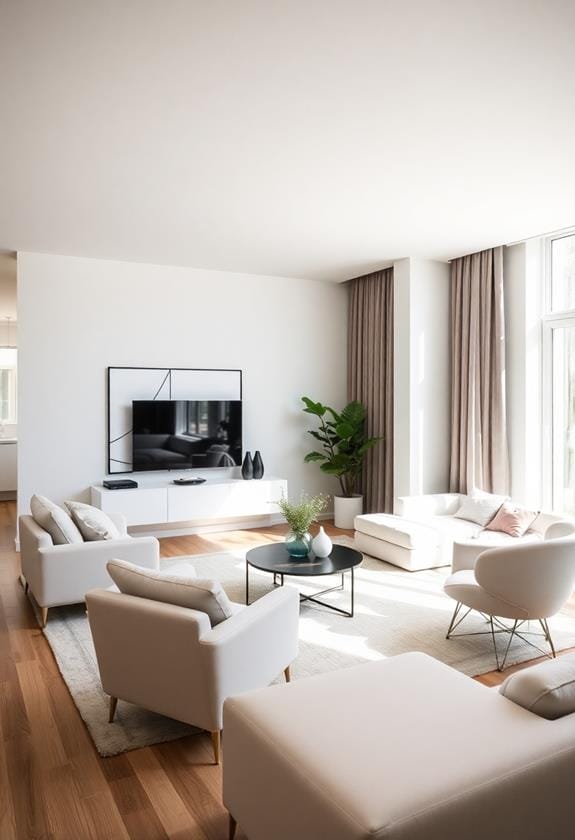
In the quest for a more spacious and harmonious small living room, embracing minimalism can be your best strategy. By focusing on simplicity, you create a room that feels open and inviting, even if space is limited. "Design Tips" for small spaces often stress the importance of simplicity and functionality. Start by evaluating what's truly essential in your living space. Ask yourself if each item serves a purpose or brings you joy. This reflection helps in eliminating clutter and unnecessary items, making your room feel larger and more organized.
Choose a few key pieces of furniture that are functional and stylish. Opt for a sleek sofa, a simple coffee table, and perhaps a single accent chair. Keep your color palette neutral with occasional pops of color to maintain a calm and cohesive look. Use textures and patterns sparingly to add interest without overwhelming the senses.
Incorporate storage solutions that blend with your decor. Shelving units or hidden storage under seating can keep your essentials tidy while maintaining a clean aesthetic. Remember, minimalism doesn't mean bare; it's about intentional design choices that reflect your lifestyle. By prioritizing quality over quantity, you'll create a serene and functional living space that feels much larger than it actually is.
Utilize Mirrors Strategically
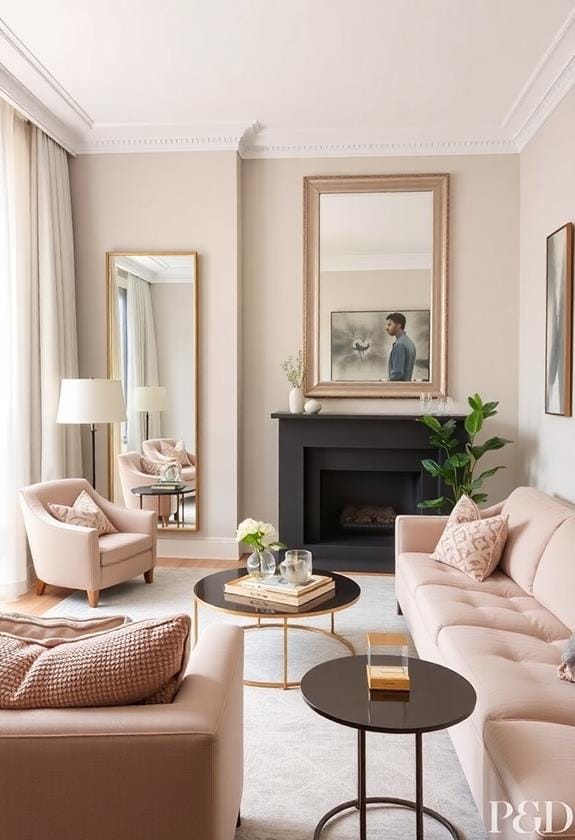
Mirrors, used strategically, can be a powerful tool in transforming your small living room. They reflect light and create the illusion of more space, making your room feel brighter and more open. Start by placing a large mirror opposite a window. This simple trick not only bounces natural light around but also draws the eye, expanding your perception of the room's dimensions. If your living room lacks windows, consider positioning a mirror behind a light source, like a lamp or a pendant light, to mimic this effect. Additionally, mirrors can be just as effective in small bedroom organization by helping create the illusion of a larger space, making it more visually appealing.
When hanging mirrors, think about height and orientation. A vertical mirror can emphasize the height of your ceiling, giving the impression of more vertical space. Conversely, a horizontal mirror can make a narrow room seem wider. You might also try a gallery of smaller mirrors. This can add a decorative element while still achieving the space-enhancing benefits.
Don't forget about framed mirrors, which can serve as art pieces, adding character without overcrowding the room. Choose frames that complement your existing decor for a cohesive look. By carefully considering mirror placement, you'll maximize your living room's potential, making it a more inviting and visually appealing space.
Opt for Light Color Schemes
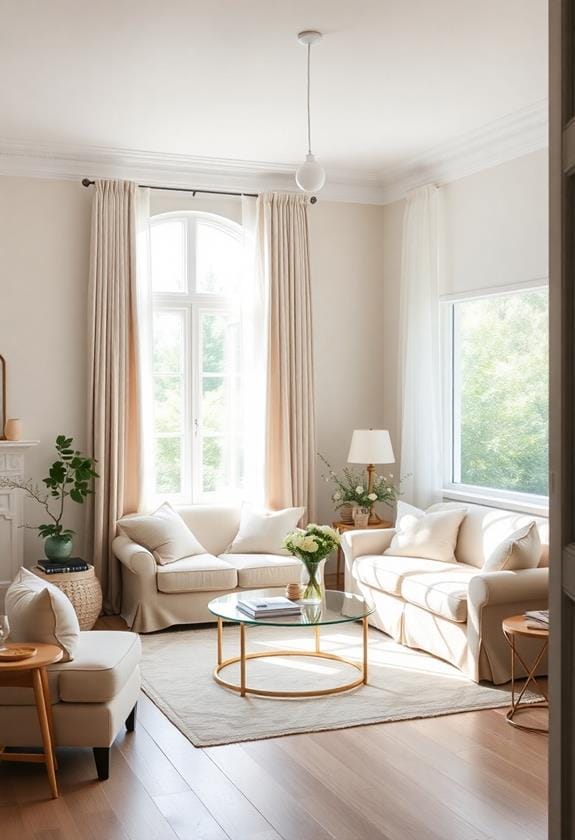
Embracing light color schemes can dramatically enhance the sense of space in a small living room. Light hues, such as whites, creams, and soft pastels, reflect more light than darker shades. This reflection creates an illusion of openness, making your room feel larger and more inviting. When you paint your walls in a light color, you set a bright, airy foundation that allows the room to breathe. Consider choosing a neutral palette that not only maximizes space but also provides a versatile backdrop for various decor styles. Utilizing light-colored furniture can maintain a cohesive look while enhancing the perception of space. In addition to walls, think about incorporating light colors into your furniture and accessories. Opt for sofas, chairs, or coffee tables in soft tones, which can seamlessly blend with the walls, creating a cohesive and expansive look. You might also add light-colored curtains or rugs to maintain this spacious feel. A few well-placed colorful accents can add personality without overwhelming the room.
Don't forget about natural light. Amplify it by using sheer window treatments that let sunlight flood the space. This combination of light colors and natural brightness can transform your small living room into a serene oasis, full of life and charm.
Create Defined Zones
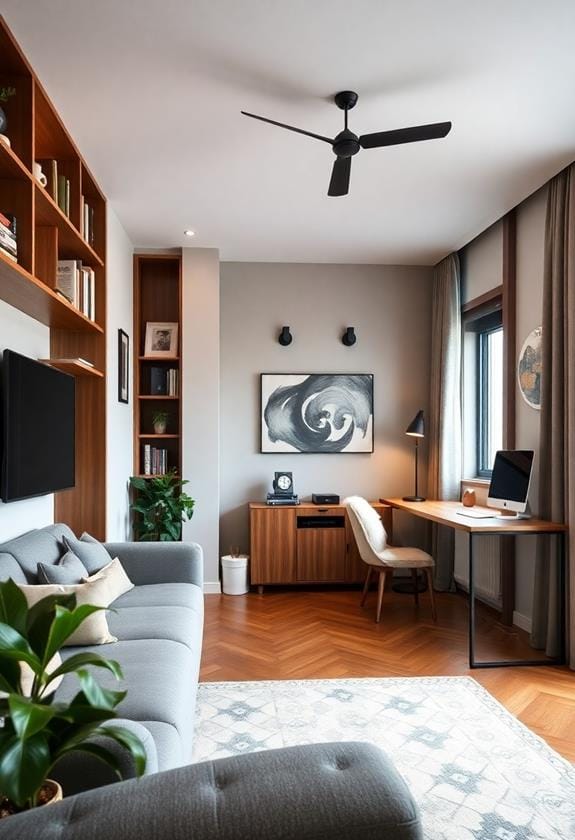
By thoughtfully arranging your furniture and decor, you can effectively create defined zones in a small living room, maximizing both function and style. Start by identifying the primary activities you want to accommodate, such as lounging, entertaining, or working. Consider incorporating multifunctional furniture to enhance usability and maintain a clutter-free environment. Once you have a clear idea, use your furniture to delineate these areas. Position your sofa to anchor the lounging zone, facing either a focal point like a fireplace or a television. A small rug can further define this space, adding warmth and structure.
Next, consider a reading nook or workspace. A compact armchair paired with a side table can establish a cozy spot for reading or casual work. If you entertain frequently, incorporate a conversation area using a couple of chairs or an ottoman that can double as seating. This not only creates a social zone but also guarantees versatility.
Incorporate Storage Solutions
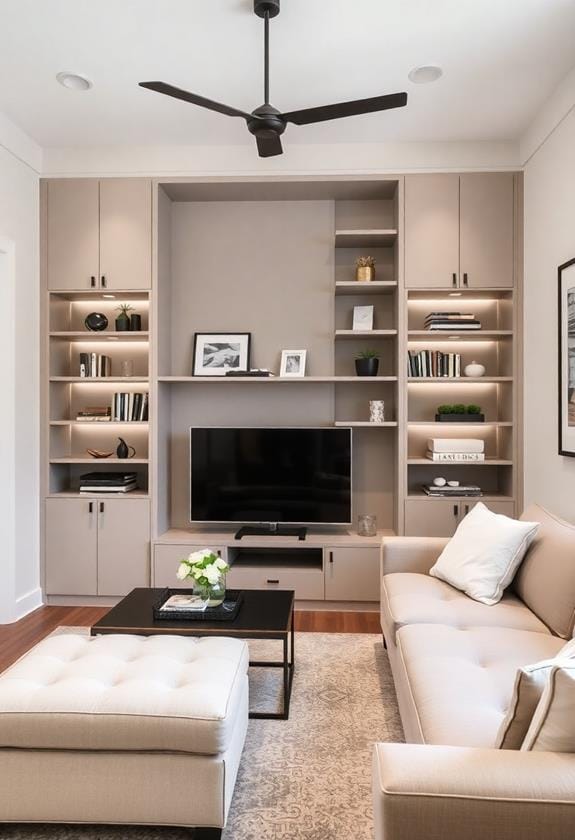
Storage is key when you're working with a small living room. Making the most of your space means finding creative ways to keep things tidy without sacrificing style. By incorporating smart storage solutions, you can maintain a clutter-free environment that feels both spacious and welcoming. One way to achieve this is by using multifunctional furniture designed for tiny homes, which combines practicality and aesthetics. Here are some ideas to inspire you:
- Floating Shelves: Wall-mounted shelves are your best friends in small spaces. They free up floor space and allow you to display books, plants, or decorative items. Plus, they add a touch of sophistication to your room.
- Multi-purpose Ottomans: Choose ottomans that double as storage bins. They provide a hidden spot for blankets, magazines, or toys, all while serving as an extra seat or footrest. It's a clever way to keep essentials accessible yet out of sight.
- Built-in Cabinets: If possible, invest in built-in cabinets or wall units. They offer a sleek, cohesive look and provide substantial storage without overwhelming your space. With these, you can keep your living room organized and stylish.
Use Compact Furniture

Often, maximizing a small living room begins with choosing the right compact furniture. Selecting pieces that are appropriately sized can dramatically improve the functionality and feel of your space. Start by identifying furniture that serves multiple purposes, like a sofa bed or a coffee table with built-in storage, to maximize utility without crowding your room.
Consider opting for slim-profile pieces that offer comfort without the bulk. A loveseat or a pair of armchairs can provide ample seating without overwhelming the room. When picking tables, choose those with slender legs and glass tops to create an illusion of openness. This not only helps in conserving space but also maintains a visually light environment, reducing any sense of clutter.
Additionally, prioritize furniture that can be easily moved or rearranged. Pieces on wheels or lightweight items allow you to adapt your layout to different needs and occasions. Don't forget to measure your space before purchasing any furniture to guarantee each piece fits perfectly. By selecting compact furniture, you'll create a more open, inviting living room, making it a comfortable space to relax and entertain, despite its smaller size.
Focus on Lighting
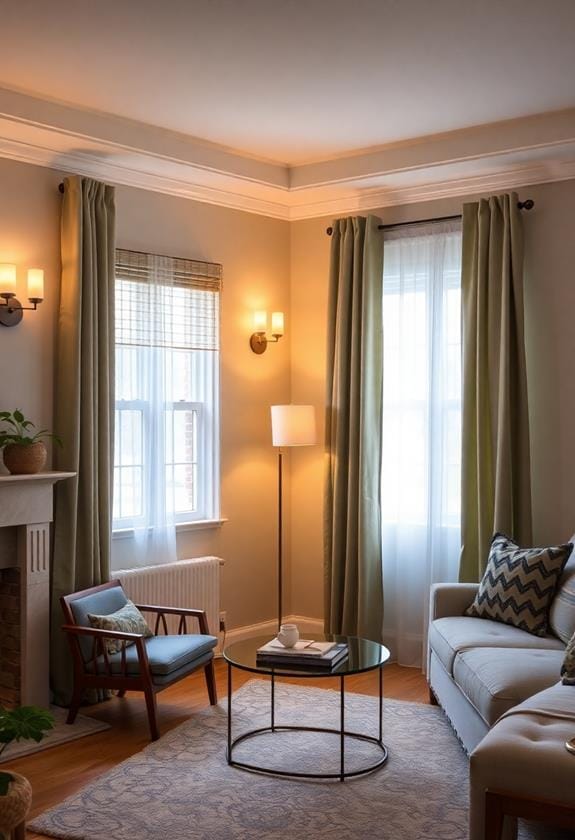
Illuminate your small living room effectively to enhance its ambiance and functionality. Proper lighting can make your space feel bigger and more inviting. Start by considering the natural light available. Don't block windows with bulky furniture, and use sheer curtains to allow sunlight to flood in. If natural light is limited, or during evenings, layer your lighting to create a warm and cozy atmosphere.
Here's how you can transform your space with lighting:
- Overhead Lighting: Install a stylish ceiling light to provide general illumination. A statement fixture can also serve as a focal point, adding character and style to your room.
- Task Lighting: Use table lamps or floor lamps for activities like reading. These focused light sources help carve out functional spaces within your living room, making it versatile and practical.
- Accent Lighting: Highlight artwork or architectural features with wall sconces or spotlights. This not only adds depth but also creates an interesting visual dynamic.
Experiment With Layouts
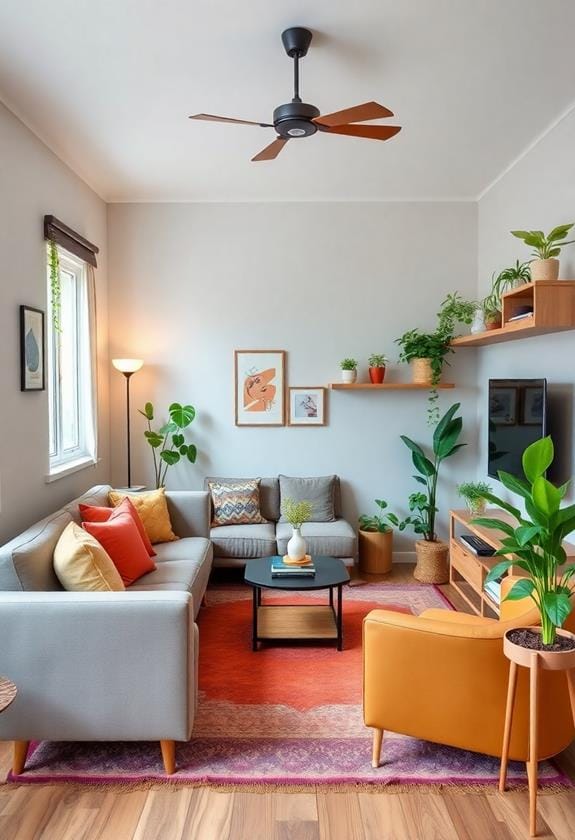
Reimagining your small living room's layout can greatly impact its functionality and feel. By experimenting with different arrangements, you open up possibilities that can transform the space into a more welcoming and practical area. Start by evaluating the room's flow. Consider how people move through the space and identify any obstacles that might hinder movement. Once you've identified these, think about rearranging your furniture to create a more open path.
Don't hesitate to try unconventional arrangements. Sometimes, placing your sofa at an angle can make the room appear larger or create an interesting focal point. You might also think about swapping the positions of larger pieces, like moving your TV stand to a different wall, which can change the room's dynamics entirely.
Consider using multi-functional furniture, like ottomans that double as storage, to maximize utility. These pieces can be easily shifted around, allowing you to adapt the layout to your needs. Remember, the goal is to create a space that not only looks good but also serves your lifestyle effectively. Take photos of each setup, compare them, and don't be afraid to make further changes until the room feels just right for you.
Frequently Asked Questions
How Can I Make My Small Living Room Feel More Inviting?
Did you know that 90% of people feel that lighting affects their mood? To make your small living room inviting, focus on lighting first. Use a mix of ceiling lights, floor lamps, and table lamps to create layers of light. Choose warmer bulbs to add coziness. Arrange furniture to facilitate conversation, ensuring there's enough space to move around comfortably. Add soft textures like throws or cushions to enhance warmth and create a welcoming atmosphere.
What Are Some Creative Ways to Add Personality to a Small Space?
To add personality to your small space, consider incorporating bold artwork or colorful throw pillows. These elements can create a focal point without overwhelming the room. Use unique lighting fixtures to add character and warmth, ensuring your space feels inviting. Display personal items like travel souvenirs or family photos on shelves or in a gallery wall arrangement. Opt for multifunctional furniture with unique designs to maximize space and express your style creatively.
How Do I Balance Aesthetics and Functionality in a Small Living Room?
Balancing aesthetics and functionality in a small living room requires thoughtful planning. Focus on multi-purpose furniture, like a stylish sofa bed or an elegant storage ottoman, to maximize space. Choose a color palette that reflects your personality while maintaining harmony. Incorporate vertical storage to keep the area tidy, and use mirrors to create an illusion of space. By blending beauty with practicality, you'll make your small living room both inviting and efficient.
What Are Some Budget-Friendly Ways to Enhance a Small Living Room?
You can enhance your small living room on a budget by incorporating multi-functional furniture like a storage ottoman or a foldable coffee table. Use mirrors strategically to create an illusion of space, and add inexpensive, vibrant throw pillows for a pop of color. Rearrange existing furniture to improve flow, and utilize vertical space with shelves. Don't overlook DIY projects, like painting an accent wall, to infuse personality without breaking the bank.
How Can I Incorporate Greenery in a Small Living Room Without Overcrowding?
Oh, the age-old dilemma: how to transform your living room into a jungle without becoming Tarzan. Start with vertical space—shelves are your best friends. Use hanging planters or wall-mounted pots to keep your floor clear. Opt for smaller plants like succulents or air plants, which require minimal space. A single statement plant, like a fiddle leaf fig, can also add drama without cluttering. Remember, less is more in your cozy green oasis.

